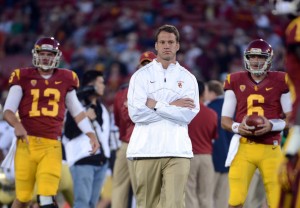But let’s puts everything aside — Kiffin for being Kiffin, the fact that USC had 1st and goal from the Notre Dame 2 with over 5 minutes remaining and then proceeded to waste over 150 seconds of clock — and look at one particular decision. Facing 4th and goal from the Notre Dame 1-yard line, trailing by 9 points with 2:33 left, Kiffin decided to go for it.
This clearly defies conventional wisdom, and when the move failed, it opened him up to even more criticism. But was it the right call? According to Brian Burke, if this had been an NFL game, the correct call would have been to kick the field goal.
That may not surprise traditionalists, but readers of this blog and Advanced NFL Stats may be surprised to find that, according to the 4th Down Calculator, when trailing by 9 with 2:33 remaining, you need an 87% chance of converting to make going for it the correct call. (I will note that if you are trailing by 10, things change dramatically and going for it is the correct play.)
But this was not an NFL game. Burke’s model is based on two assumptions that are relevant here: one, the team has an average number of timeouts remaining, and two, that the clock will stop with 2:00 to go. USC had one timeout left (which is probably below average for this situation) and there is no two-minute warning in college football. So it’s likely that using 2:33 is not the correct number to use the 4th down calculator for college.
If you use 2:33 remaining, you need an 87% chance of converting to make going for it the correct call.
But, according to the same model, if you use 2:03, it drops to 64%.
If you use 1:33, it drops to 13%.
Obviously figuring out which input to use is very important. However, let’s think about it in a different context.
If USC scores a touchdown and does not onside kick (which I don’t think they do), ND gets the ball at roughly the 25-yard line with 2:25 left. On 1st and 10, they run, USC calls timeout, and there is 2:20 left. On second down, Notre Dame runs, 40 seconds tick off, and there is 1:35 left. Rinse, repeat, and Notre Dame punts with 50 seconds left. This means USC gets the ball with roughly 40 seconds left at say, their own 45.
Here college football’s rules benefit the Trojans because the clock stops momentarily on first downs. At this point, it comes down to this:
[continue reading…]

